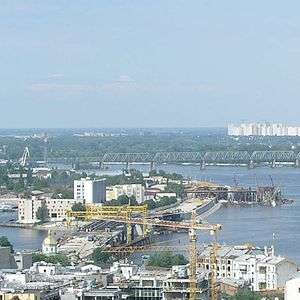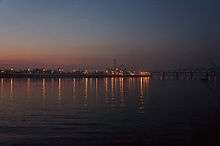Rybalskyi Peninsula
Rybalskyi Island (Ukrainian: Рибальський півострів, ![]()


History
The peninsula was formed from clay deposits, which served as the left-bank of the Pochaina River. Rybalskyi Peninsula takes its name from the fishermen of Podil who once lived on it. In 1897-1899, the peninsula was raised and strengthened, which would later enable it to house a local shipyard for steamboats (engineered by M.Maksymovych), as well as to form the newly built Kiev Harbour between the peninsula and the Podil riverbank.
In 1926-1930, an electrical power station was constructed in the north-western part of the peninsula (engineered by B. Domanskyi and M. Parusnikov), today Thermal power station-2 (power and heat producing station). During this time an industrial area has developed here. On the banks of the harbor in the Sailors Park a ship-monument to Monitor Zhelezniakov was installed on a pedestal. In 1929 Petrovsky Railway Bridge was finally officially opened after 10 year of abandonment. In the end of the 1930s, the Kuznya na Rybalskomu shipbuilding factory was reconstructed (now it owned by President of Ukraine Petro Poroshenko.
During the Second World War, the peninsula suffered heavy damage from bombings. After the war, reconstruction began, while new factories and foundations were constructed. The Petrovsky Railway Bridge, shipyard, power station, and others were rebuilt.
Present infrastructure

In 1961, piers of the new Kiev River Port was built in the Harbour, and in 1963 the Kiev cable-stayed bridge was constructed to provide road access to the Rybalskyi Peninsula from the center of the city. In 2001 the bridge was closed to a vehicle traffic, because of its conditions. In 2009 it was closed completely and eventually was partially disassembled with construction of the new Kiev Harbor Bridge.
The main compound of the GUR MOU, the military intelligence institution, is located on the Rybalskyi Peninsula.
Development plans
In 2005, plans were released for the perspective reconstruction of the Rybalskyi Peninsula, by the year 2020.[1] Included into the plan are residential and business buildings, underground parking, hotel-office combination buildings, trade centers, and socio-cultural constructions.[2] In addition, the Kiev Metro station, Sudnobudyvina of the Podilsko-Vyhurivska Line, is currently being constructed on the peninsula, which will provide better access to the peninsula from the city.[3]
References
- "Project of reconstruction of the Rybalskyi Peninsula". archunion.com.ua (in Russian). December 5, 2005. Archived from the original on September 27, 2007.
- "Project of reconstruction of the Rybalskyi Peninsula". archunion.com.ua (in Russian). December 5, 2005. Archived from the original on May 10, 2013.
- "Project of Podilsko-Voskresenska Line metro stations". archunion.com.ua (in Russian). March 7, 2007. Archived from the original on May 16, 2008.